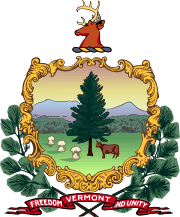Charles J. Bell
| Charles James Bell | |
|---|---|
 Official Vermont State House portrait | |
| 50th Governor of Vermont | |
|
In office October 6, 1904 – October 4, 1906 | |
| Lieutenant | Charles H. Stearns |
| Preceded by | John G. McCullough |
| Succeeded by | Fletcher D. Proctor |
| Personal details | |
| Born |
March 10, 1845 Walden, Vermont |
| Died |
September 25, 1909 (aged 64) New York City |
| Political party | Republican |
| Spouse(s) | Mary Louisa Perry (1849–1918) |
| Profession | Farmer and horse breeder |
Charles James Bell (March 10, 1845 – September 25, 1909), a Republican, was the 50th Governor of the U.S. state of Vermont from 1904 to 1906.
Early life and education
He graduated from Peacham Academy and at 17 enlisted for the Civil War in Company B, 15th Vermont Infantry Regiment.
Military experience
After he was mustered out he reenlisted in Company C, 1st Vermont Cavalry Regiment and was promoted to Corporal in 1864. Bell was wounded at Appomattox Station in April, 1865, and was mustered out in June. He then returned to Walden, where he farmed and raised horses.
Post Civil War experience
In addition to operating his farm and breeding horses, Bell was elected and appointed to various local offices, including school board member, selectman, and chairman of the select board.
A Republican, he served in the Vermont House of Representatives from 1882 to 1883, and the Vermont Senate from 1894 to 1895.
He was a member of the state Board of Railroad Commissioners from 1894 to 1896, and the state Board of Agriculture from 1896 to 1904.
From 1898 to 1902 Bell was Secretary of the state Board of Cattle Commissioners.
Bell also served as President of the Caledonia County Agriculture Society, a Director of the Vermont Agricultural Society, Treasurer and Master of the Vermont Grange, and an executive committee member and Secretary of the National Grange.
Election as Governor
Bell was nominated for Governor in 1904. He easily won the general election, and served two years, in keeping with the Vermont Republican party's "Mountain Rule".
(Under the Mountain Rule, the Republican party alternated candidates for Governor and Lieutenant Governor between the east and west side of the Green Mountains, identified nominees years in advance, and restricted governors to two years in office.
Bell was from the west side of the Green Mountains, and his predecessor, John G. McCullough and successor, Fletcher D. Proctor were from the east. Republicans also apportioned the state's two U.S. Senate seats between each side of the Green Mountains.
The Republican party maintained this rule, with few exceptions, for more than 100 years, winning every election for Governor from the 1850s until 1960, and every U.S. Senate election from the 1850s until 1974.)
During his administration Bell was involved in a controversy that gained national attention. He was besieged by pleas to commute the sentence of Mary Rogers, who had been convicted of murdering her husband. Bell reconsidered her case, but ultimately decided to allow the original sentence to be carried out, and Mary Rogers was executed by hanging.
Career after governorship
After leaving office Bell returned to his agricultural interests and remained active in the Grange and other farming organizations. In 1906 he received an honorary degree from Norwich University, and one from the University of Vermont.
Death and interment
Bell became ill while visiting New York City. He decided to return home early, and died from a heart attack while on a train at Grand Central Station. He was buried in North Walden Cemetery, North Walden, Vermont.
References
- Encyclopedia of Vermont Biography, edited by Prentiss Cutler Dodge, 1912, page 51
- Norwich University, 1819–1911; her history, her graduates, her roll of honor, edited by William Arba Ellis, 1911, Volume 3, page 516
- Biography, Charles James Bell, Manual of the Legislature of Vermont, published by the Vermont General Assembly, 1904, page 53
- In memoriam, Charles J. Bell, published in Proceedings of the Vermont Historical Society, 1910, page 66
- Newspaper article, Vermont Republican Ticket: Charles J. Bell for Governor, New York Times, July 1, 1904
- Newspaper article, Mrs. Rogers Unmoved by News of Reprieve, New York Times, February 3, 1905
- Newspaper article, Her Neck Broken By Fall Of Drop, Mary Rogers Met Death With Wonderful Fortitude, Boston Globe, December 9, 1905
- Newspaper article, Ex-Gov. C.J. Bell's Death, New York Times, September 27, 1909
- Ex-Gov. Bell Of Vermont Is Dead: Stricken by Heart Disease on Railroad Train in New York, About to Go to Boston, Detroit Free Press, September 26, 1909
| Political offices | ||
|---|---|---|
| Preceded by John G. McCullough |
Governor of Vermont 1906–1908 |
Succeeded by Fletcher D. Proctor |
